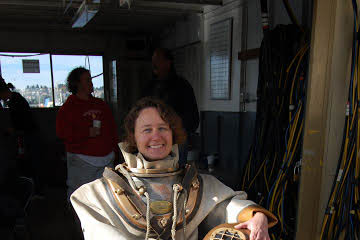 Former Beatles drummer Ringo Starr sang about being “under the sea in an octopus’s garden.” As a qualified scuba diver and instructor, Sherri Ferguson is used to being under the sea. But invading the home of an octopus was not on her bucket list, despite the best efforts of a member of the species.
Former Beatles drummer Ringo Starr sang about being “under the sea in an octopus’s garden.” As a qualified scuba diver and instructor, Sherri Ferguson is used to being under the sea. But invading the home of an octopus was not on her bucket list, despite the best efforts of a member of the species.
“A giant Pacific octopus grabbed me by the legs, wrapping three of its giant tentacles around my ankles, knees and thighs, while trying to pull me into its den,” said Ferguson. “I waited it out and after a few pictures by my buddy it let go and we continued on our way. It was the only time I ever thought I may need my knife for defence on a dive. Thankfully, I didn’t. By the way, you cannot peel an octopus off a vulcanized rubber drysuit no matter how hard you try.”
Until her first dive in 1994 off the island of Dominica, she had not considered the sport. “The first dive was on a whim when a dreadlock Rastafarian asked me if I wanted to try scuba diving, I thought ‘hey, why not.’ After spending all my disposable income on dive gear and dive charters, along with training to become a Dive Master, I figured I better start getting paid for doing what I loved. I went on to do my instructor course, run a dive shop and get my occupational divers certification.”
Asked who she would like to dive with, Ferguson said her choice would be Zale Parry. “I simply adore her and she has been such a pioneer female diver.” Parry was already a skilled diver when she joined the cast of Sea Hunt, an underwater television series that ran from 1958 to 1961 and starred Lloyd Bridges. In 1955 she became the first woman to appear on the cover of Sports Illustrated. Parry was a record-setting female deep diver and an advocate of hyperbaric chambers for divers.
Ferguson, 48, has been building quite a legacy for herself. She is working on her PhD in biomedical physiology and is employed as the Director of the Environmental Medicine and Physiology Unit at Simon Fraser University’s Faculty of Science.
Ferguson is a diving safety officer at both the University of British Columbia and the University of Victoria. With the Canadian Standards Association, she is a chair of Hyperbaric Operations. She is a member at large of the Canadian Undersea and Hyperbaric Medical Association’s Board of Directors, and an executive member of the Canadian Association for Underwater Science’s Board of Directors.
Her diver qualifications are: Instructor Trainer SDI & TDI; Instructor Certifier SSI (inactive); Master Scuba Diver Trainer PADI (inactive); Occupational Diver & Instructor Divers Certification
Board of Canada; Hyperbaric Chamber Operator and Supervisor and Diving Safety Officer for the Canadian Association for Underwater Science.
On returning home to British Columbia following that first dive from Dominica, Ferguson had found her passion in scuba but now needed the qualifications to teach it. She obtained her Dive Master certification.
Like most divers. Ferguson has her favourite destinations. In British Columbia, her top location is Port Hardy, but her favourite dive site is Browning Pass Wall, where she has “encounters with wolf eels and octopuses.”
Internationally, her top three dive sites include:
- Poor Knights Islands, off the coast of Tutukaka, New Zealand, which have been rated as one of the top 10 dive sites in the world by Jacques Cousteau. They feature great underwater visibility and diverse marine life.
- Galapagos, to see an iguana under water
- Norway, “for a chance to be in the water with an Orca”
Like many divers, Ferguson is concerned about the environment.
“I am passionate about our problem with plastic. No straws folks! They are so unnecessary. We just have to end our relationship with throwing things away and using petroleum to make plastic that will never go away. It litters beaches all over the world. I have seen it from Africa to the Arctic. It kills marine life and it destroys our planet by increasing our demand for oil.”
The sea life that is endangered includes descendents of that huge Pacific octopus that was urging Sherri Ferguson to visit its garden under the sea.






